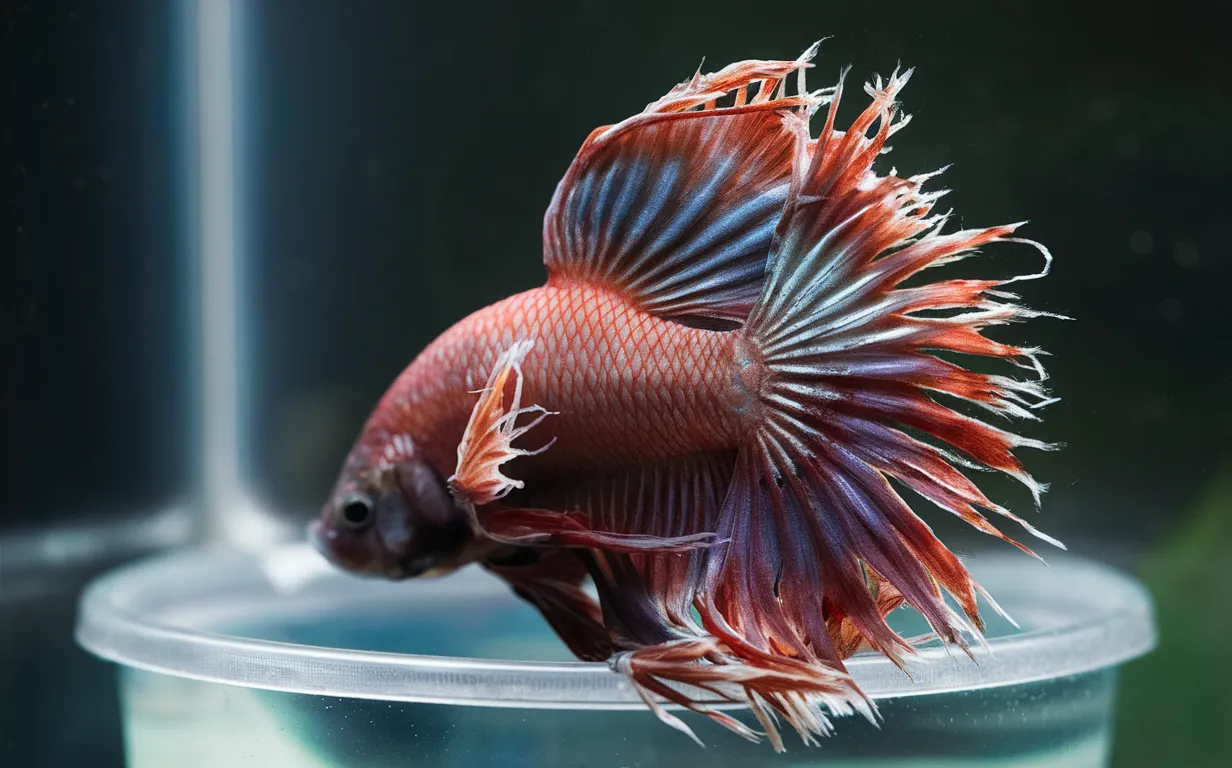If you’ve noticed that your betta fish’s fins look shredded or tattered, there could be a few potential causes. Betta Fish, also known as Siamese fighting fish, are beautiful and delicate creatures that require special care. Understanding why their fins may become damaged can help you address the issue and keep your betta healthy and thriving.

Why Does My Betta Fish Fins Look Shredded?
1. Fin Biting
One of the most common reasons for shredded betta fins is fin biting. Bettas are known to nip at their own fins, which can cause them to appear ragged or torn. This behavior can be triggered by stress, boredom, or improper tank conditions.
2. Tank Decor
Sharp or rough decorations in the tank, such as jagged rocks, driftwood, or gravel, can easily catch and tear a betta’s delicate fins. It’s important to ensure that all tank decorations are smooth and betta-friendly.
3. Aggression from Tank Mates
If your betta is housed with other fish, they may be nipping at the betta’s fins, causing the shredded appearance. Bettas are territorial and do not do well in community tanks, especially with other aggressive or fin-nipping species.
4. Water Quality Issues
Poor water quality, such as high levels of ammonia, nitrites, or nitrates, can also lead to late deterioration in bettas. Maintaining proper water parameters is crucial for the health and well-being of these fish.
5. Disease
In some cases, shredded betta fins can be a symptom of an underlying disease, such as fin rot or bacterial infections. These conditions require prompt treatment to prevent further damage and potential loss of the fish.
Preventing and Treating Shredded Betta Fins
To prevent and treat shredded betta fins, consider the following steps:
- Ensure the tank has appropriate decorations and furnishings that are smooth and betta-friendly.
- Avoid housing bettas with other aggressive or fin-nipping fish species.
- Maintain excellent water quality through regular water changes and testing.
- Observe your betta’s behavior and address any potential sources of stress or boredom.
- If the fins appear to be deteriorating due to disease, consult a veterinarian or experienced aquarist for proper treatment.
What Are The Best Tank Conditions For Betta Fish To Thrive?
Providing the right tank conditions is crucial for the health and well-being of betta fish. Here are the best tank conditions for bettas to thrive:
Tank Size
Bettas do best in tanks or aquariums that are at least 2.5 gallons in size. Larger tanks, around 5 gallons or more, are even better as they provide more swimming space and water volume.
Water Temperature
Bettas are tropical fish and prefer warm water temperatures between 78-82°F (25.5-27.8°C). Maintaining a consistent water temperature is important, as sudden temperature fluctuations can stress the fish.
Water Quality
Excellent water quality is essential for bettas. The water should be clean, with low levels of ammonia, nitrites, and nitrates. Perform regular water changes of 25-50% weekly to keep the water parameters in check.
PH and Hardness
Bettas prefer a slightly acidic to neutral pH range of 6.5-7.5. The water hardness should be in the soft to moderately hard range, around 5-15 dGH.
Filtration and Aeration
Bettas do not tolerate strong water currents well. Use a gentle, low-flow filter and consider adding an air stone or sponge filter to provide gentle water movement and oxygenation.
Lighting
Bettas do well with moderate lighting, whether it’s natural daylight or aquarium lighting. Avoid bright, intense lighting as it can stress the fish.
Decorations and Hiding Spots
Provide plenty of live or artificial plants, rocks, and decorations that offer hiding spots and areas for the betta to rest. This helps reduce stress and gives the fish a sense of security.
Tank Mates
Bettas are territorial and do not do well with aggressive tank mates. It’s best to house bettas alone or with peaceful, calm species that won’t nip at their fins, such as certain types of snails or shrimp.
By maintaining these optimal tank conditions, you can create a thriving environment for your betta fish to live a long and healthy life.
What Are The Signs Of Stress In Betta Fish?
Here are some common signs that a betta fish is experiencing stress:
- Fin Clamping : The betta’s fins will appear tightly clamped or closed against its body. This is one of the most obvious signs of stress.
- Hiding Behavior : A stressed betta will often hide a lot, spending most of its time tucked away in plants or decorations, rather than swimming freely.
- Erratic Swimming : The betta may exhibit darting, jerky, or rapid swimming patterns, rather than its usual smooth, calm movements.
- Loss of Appetite : A stressed betta may refuse to eat or have a decreased appetite, even for its favorite foods.
- Discoloration : The betta’s colors may appear dull, faded, or washed out when it is stressed.
- Lethargy : A stressed betta may appear sluggish, lazy, or lethargic, with little to no activity.
- Clamped Gill Covers : The betta’s gill covers (opercula) may appear tightly closed or clamped down, rather than the usual open, relaxed position.
- Increased Aggression : In some cases, a stressed betta may become more aggressive and flare its fins more frequently.
It’s important to note that these signs can also be indicative of other health issues, so it’s best to observe the betta’s behavior and environment closely to determine the cause of the stress. Addressing the underlying stressor is crucial for the betta’s well-being.
Conclution
By understanding the common causes of shredded betta fins and taking proactive steps to address them, you can help keep your betta healthy and vibrant.

Related Posts
Female Betta Care: A Comprehensive Guide
Understanding Betta Fish Water
What Are Clamped Fins On Betta?